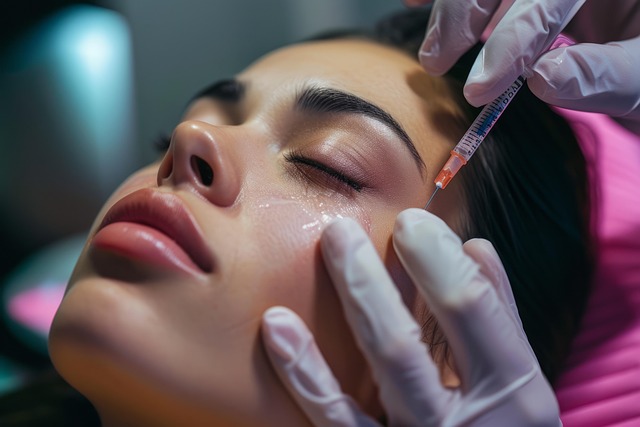Neurological disorders impacting muscle control can lead to social isolation. Botox offers a safe, effective treatment for managing these symptoms, particularly in jawline slimming. Derived from bacteria, it relaxes muscles, alleviating tension and pain while enhancing facial aesthetics. Benefits include reducing double chins, minimizing facial tics/spasms, treating TMJ dysfunction, and bruxism. Non-invasive, with quick recovery, Botox improves quality of life for patients with neurological conditions. However, side effects like bruising, muscle weakness, and the need for repeated treatments must be considered. As research continues, Botox's potential in neurology expands beyond aesthetics to treat diverse disorders.
In this comprehensive guide, we explore the innovative use of botox as a therapeutic tool for neurological disorders. While commonly known for its aesthetic benefits, such as jawline slimming, botox has shown remarkable potential in treating various neurological conditions. From understanding the impact of these disorders to delving into the mechanisms behind botox’s effectiveness, this article offers insights into its role in medicine. We discuss safety considerations, successful case studies, and emerging research, shedding light on how botox is revolutionizing neurology.
Understanding Neurological Disorders and Their Impact

Neurological disorders encompass a wide range of conditions affecting the brain, spine, and nerves, leading to diverse symptoms such as muscle weakness, spasms, or chronic pain. These disorders can significantly impact an individual’s quality of life, causing physical discomfort, disability, and even social isolation. One common challenge many patients face is the appearance of facial distortions or uneven features due to involuntary muscle contractions.
In this context, Botox has emerged as a promising treatment option, offering several benefits for individuals with neurological disorders. Specifically, for those seeking jawline slimming, Botox injections can be highly effective. By relaxing specific muscles in the jaw and face, it can reduce the appearance of a squared or angular jawline, providing a more aesthetically pleasing contour. This non-invasive procedure has gained popularity as a safe and temporary solution for those looking to enhance their facial features while also managing neurological symptoms.
Introduction to Botox: A Brief Overview

Botox, short for botulinum toxin, is a protein produced by bacteria that has found its way into the medical and cosmetic world. It’s renowned for its ability to temporarily paralyze or weaken muscles, leading to various therapeutic applications. When injected in precise amounts, Botox offers more than just aesthetic benefits; it’s a game-changer in managing neurological disorders.
One notable use of Botox is for jawline slimming, which has gained significant attention due to its non-surgical approach. The benefits extend beyond cosmetic enhancement; it can alleviate symptoms associated with certain neurological conditions. For example, it’s effective in treating chronic jaw pain and muscle tension, often linked to disorders like temporomandibular joint (TMJ) dysfunction. By relaxing the facial muscles, Botox can reduce the intensity of these symptoms, providing patients with a more comfortable and relaxed appearance.
The Role of Botox in Medical Treatments

Botox, a protein derived from bacteria, has emerged as a versatile tool in medical treatments beyond its well-known cosmetic applications. Its unique properties allow it to relax muscles and reduce involuntary movements, making it a valuable option for managing neurological disorders. One notable area where Botox is gaining recognition is in the treatment of facial tics and spasms, particularly along the jawline. The benefits of Botox for jawline slimming are significant; by reducing muscle tension, it can minimize unwanted facial expressions and provide a more relaxed, aesthetically pleasing appearance.
This therapeutic use of Botox offers a non-invasive approach to treating conditions like bruxism (teeth grinding) and temporomandibular joint disorder (TMJ), which often lead to jawline fatigure and discomfort. By relaxing the muscles responsible for these movements, Botox can alleviate symptoms, enhance facial symmetry, and potentially slow down the aging process in the lower face. The procedure is generally well-tolerated, and many patients experience improved quality of life without the need for more aggressive interventions.
Benefits of Botox for Jawline Slimming

Botox has emerged as a popular non-surgical treatment for jawline slimming, offering several benefits to those seeking to enhance their facial aesthetics. The primary advantage lies in its ability to reduce the appearance of a double chin, a common concern for many individuals. By relaxing the muscles responsible for skin movement, Botox helps smooth out the contour of the jawline and neck, providing a more defined and sculpted look.
This procedure is particularly beneficial for people with certain neurological disorders that contribute to muscle tightness or spasm in the jaw area. It offers a temporary yet effective solution to alleviate excessive tension, leading to improved facial balance and reduced signs of aging. The non-invasive nature of Botox makes it an appealing option for individuals who prefer a more subtle approach to aesthetic enhancements.
How Botox Works for Neuromuscular Conditions

Botox, a protein derived from bacteria, has found its niche in treating neurological disorders, particularly neuromuscular conditions that affect facial aesthetics and function. Its mechanism of action involves blocking the transmission of nerve signals to specific muscles, leading to relaxation and reduced contraction. This process is especially beneficial for conditions like bruxism (teeth grinding), which causes jaw clenching and tension, resulting in a slimming effect on the jawline—a sought-after benefit among many patients.
The benefits extend beyond aesthetic improvements. By reducing muscle activity, Botox can alleviate associated symptoms like chronic pain, headaches, and muscle fatigue. In cases of abnormal facial expressions caused by neurological impairments, Botox can help restore more natural movements, enhancing overall quality of life. Its non-invasive nature and relatively quick recovery time make it an attractive option for individuals seeking relief from these conditions without major surgeries or extensive rehabilitation.
Safety and Efficacy Considerations for Botox Therapies

Botox therapies, while renowned for their benefits in jawline slimming and aesthetic enhancements, require careful consideration regarding safety and efficacy. These treatments involve injecting a neurotoxin into specific muscles to relax them, which can lead to significant improvements in facial contouring and reducing the appearance of jowls. However, it’s crucial to understand that not all individuals are suitable candidates for Botox due to potential side effects and contraindications.
Safety is paramount, especially when considering the proximity of Botox injections to sensitive areas like the face and neck. Temporary bruising, swelling, or discomfort at the injection site are common, but more severe reactions are rare. Efficacy varies based on individual factors such as muscle mass, age, and overall health. For optimal results in jawline slimming, multiple sessions may be necessary, and it’s essential to consult with a qualified healthcare provider who can assess specific needs and provide expert guidance throughout the process.
Case Studies: Successful Botox Applications in Neurology

In the realm of neurological disorders, Botox has emerged as a game-changer with its diverse applications. Numerous case studies highlight successful implementations that extend beyond traditional cosmetic uses, showcasing its therapeutic potential. One notable area is jawline slimming, where Botox injections have proven effective in reducing facial tension and muscle hyperactivity. This non-invasive procedure offers a natural and subtle approach to achieving aesthetic goals, particularly for individuals with conditions like temporomandibular joint disorder (TMJ).
These case studies further demonstrate Botox’s versatility. For instance, it has been utilized to manage headaches and migraines by targeting specific muscles involved in the pain response. Additionally, its ability to relax facial muscles has shown promise in alleviating symptoms of essential tremor, improving control during motor tasks. Such applications underscore the far-reaching benefits of Botox, expanding its role beyond traditional aesthetics to include significant neurological advantages.
Potential Challenges and Side Effects to Be Aware Of

While the benefits of Botox for jawline slimming have been well-documented, it’s crucial to be aware of potential challenges and side effects. One common concern is the risk of muscle weakness or paralysis, which can occur if Botox is administered incorrectly or in excessive amounts. This could lead to difficulties with chewing, swallowing, or even speech. Other side effects may include bruising, swelling, headaches, or temporary asymmetry in facial features.
Additionally, the effects of Botox are not permanent, and treatments typically need to be repeated every few months to maintain results. The cost of these procedures can also be a significant factor, as they are not covered by most insurance plans. It’s essential for individuals considering Botox for neurological disorders or jawline slimming to carefully weigh these considerations with their healthcare provider to ensure the best and safest outcomes.
Future Prospects and Ongoing Research in Botox Neurology

The future prospects of Botox in neurological disorders look promising, with ongoing research exploring its potential beyond aesthetic applications. Recent studies have delved into using Botox as a therapeutic tool for various conditions, including tremors, migraines, and even certain mental health disorders. One area of particular interest is the benefits of Botox for jawline slimming, which has shown potential in treating conditions like temporomandibular joint disorder (TMJ). This non-invasive approach could offer relief to patients without the need for surgery or extensive medication.
Researchers are also investigating Botox’s ability to modulate nerve signals, potentially slowing the progression of neurodegenerative diseases. The versatility of this treatment is a game-changer, especially in managing symptoms and improving quality of life for those with neurological impairments. As research advances, we can expect more clinical trials and real-world applications, further expanding the role of Botox in neurology and continuing to revolutionize patient care.
